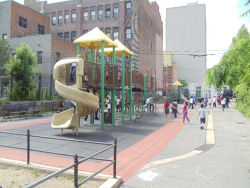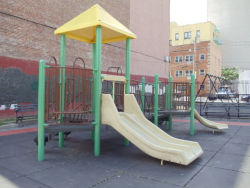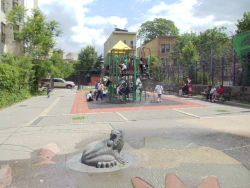Washington Park
Washington Park
George Washington (1732-1799) began his professional career as a land surveyor in Virginia and was a member of the Virginia House of Burgesses where he was an outspoken critic of British rule. He was named Commander-in-Chief of the Continental Army at the Second Continental Congress in May 1775. From 1775 to 1783 he led his poorly trained, ill-equipped troops to victory over the British in the Revolutionary War and accepted the surrender of the British General Cornwallis at Yorktown in 1781. The American colonists held him in such high esteem that he was the unanimous choice for first President when the Republic was formed. He served from 1789 to1797.
Washington was inaugurated at Federal Hall in New York City, the first Capital of the United States, on April 30, 1789. His residence at 3 Cherry Street was demolished to make way for the construction of the Brooklyn Bridge. He wielded the power of his office fairly and effectively, putting down the Whiskey Rebellion (protesting a federal tax on whiskey) in 1794; and keeping the United States from becoming involved in the conflict between France and England following the French Revolution. During his term in office, the Bill of Rights became part of the Constitution.
Despite his success, Washington wasn’t comfortable with his position as president, and considered leaving office after his first term. He was unable to resolve the disputes between Thomas Jefferson (1743-1826) and Alexander Hamilton (1757-1804), Secretaries of State and Treasury, respectively. The development of the two-party system, which evolved out the disagreements between the two cabinet members, was especially distressing for him. He resisted all pleas that he stay on and resigned after his second term on March 3, 1797. On his retirement he told a friend that he felt like a prisoner regaining his freedom.
Washington was anxious to return home to Mt. Vernon, his 45,000 acre estate on the Potomac River in Virginia. He died in1799, less than three years after leaving office
This park is bound Washington and Park Avenues and East 183rd and East 184th Streets, in the Tremont section of the Bronx. In the 1930’s Washington Avenue was an impressive thoroughfare lined with mansions, theaters, and churches. It was the street of choice for neighborhood parades. But the “flight to the suburbs” in the 1950’s and the construction of the Cross Bronx Expressway in 1964 hastened the decline of the neighborhood. Many fine buildings were demolished. Over the last twenty years, local residents began their own urban renewal and, with the help of the City, reversed the downturn.
The City assigned a section of this park bordering East 183rd Street to Parks on January 16, 1997. The adjacent lot bordering East 184th Street was assigned on July 15, 1997. Commissioner Stern named Washington Park on May 18, 1998 and renovations began in May 2001. They included the construction of a playground designed for pre-teens, a retaining wall to stabilize the site’s perimeter, and a concrete stage area. The park now boasts a basketball court with color sealer coating and World’s Fair benches. Plantings, a flagpole with a yardarm, fencing, a sundial, and swings were also added. There is substantial animal art, including coyote, rabbit, and mountain lion pictures with accompanying footprints in the concrete. The spray showers have a frog theme. City Council Member Jose Rivera, now a State Assemblyman, provided $975,000 for the renovation, and in 2001 Mayor Giuliani allocated $77,000 for additional renovations.
Check out your park's Vital Signs
Clean & Safe
Green & Resilient
Empowered & Engaged Users
Share your feedback or learn more about how this park is part of a
Vital Park System



